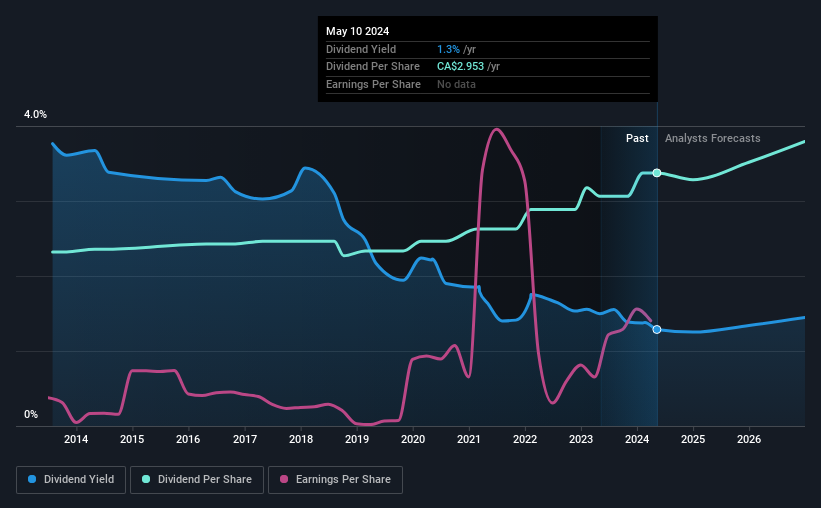Stock Analysis
- Canada
- /
- Professional Services
- /
- TSX:TRI
Thomson Reuters Corporation (TSE:TRI) Passed Our Checks, And It's About To Pay A US$0.54 Dividend

It looks like Thomson Reuters Corporation (TSE:TRI) is about to go ex-dividend in the next three days. The ex-dividend date is one business day before the record date, which is the cut-off date for shareholders to be present on the company's books to be eligible for a dividend payment. It is important to be aware of the ex-dividend date because any trade on the stock needs to have been settled on or before the record date. This means that investors who purchase Thomson Reuters' shares on or after the 15th of May will not receive the dividend, which will be paid on the 10th of June.
The company's next dividend payment will be US$0.54 per share. Last year, in total, the company distributed US$2.16 to shareholders. Based on the last year's worth of payments, Thomson Reuters has a trailing yield of 1.3% on the current stock price of CA$229.48. If you buy this business for its dividend, you should have an idea of whether Thomson Reuters's dividend is reliable and sustainable. So we need to check whether the dividend payments are covered, and if earnings are growing.
Check out our latest analysis for Thomson Reuters
Dividends are typically paid out of company income, so if a company pays out more than it earned, its dividend is usually at a higher risk of being cut. Fortunately Thomson Reuters's payout ratio is modest, at just 39% of profit. A useful secondary check can be to evaluate whether Thomson Reuters generated enough free cash flow to afford its dividend. Thankfully its dividend payments took up just 46% of the free cash flow it generated, which is a comfortable payout ratio.
It's encouraging to see that the dividend is covered by both profit and cash flow. This generally suggests the dividend is sustainable, as long as earnings don't drop precipitously.
Click here to see the company's payout ratio, plus analyst estimates of its future dividends.

Have Earnings And Dividends Been Growing?
Companies with consistently growing earnings per share generally make the best dividend stocks, as they usually find it easier to grow dividends per share. If earnings decline and the company is forced to cut its dividend, investors could watch the value of their investment go up in smoke. It's encouraging to see Thomson Reuters has grown its earnings rapidly, up 117% a year for the past five years. Earnings per share have been growing very quickly, and the company is paying out a relatively low percentage of its profit and cash flow. Companies with growing earnings and low payout ratios are often the best long-term dividend stocks, as the company can both grow its earnings and increase the percentage of earnings that it pays out, essentially multiplying the dividend.
Another key way to measure a company's dividend prospects is by measuring its historical rate of dividend growth. Thomson Reuters has delivered 3.8% dividend growth per year on average over the past 10 years. Earnings per share have been growing much quicker than dividends, potentially because Thomson Reuters is keeping back more of its profits to grow the business.
To Sum It Up
From a dividend perspective, should investors buy or avoid Thomson Reuters? It's great that Thomson Reuters is growing earnings per share while simultaneously paying out a low percentage of both its earnings and cash flow. It's disappointing to see the dividend has been cut at least once in the past, but as things stand now, the low payout ratio suggests a conservative approach to dividends, which we like. There's a lot to like about Thomson Reuters, and we would prioritise taking a closer look at it.
With that in mind, a critical part of thorough stock research is being aware of any risks that stock currently faces. Every company has risks, and we've spotted 2 warning signs for Thomson Reuters (of which 1 shouldn't be ignored!) you should know about.
If you're in the market for strong dividend payers, we recommend checking our selection of top dividend stocks.
Valuation is complex, but we're helping make it simple.
Find out whether Thomson Reuters is potentially over or undervalued by checking out our comprehensive analysis, which includes fair value estimates, risks and warnings, dividends, insider transactions and financial health.
View the Free AnalysisHave feedback on this article? Concerned about the content? Get in touch with us directly. Alternatively, email editorial-team (at) simplywallst.com.
This article by Simply Wall St is general in nature. We provide commentary based on historical data and analyst forecasts only using an unbiased methodology and our articles are not intended to be financial advice. It does not constitute a recommendation to buy or sell any stock, and does not take account of your objectives, or your financial situation. We aim to bring you long-term focused analysis driven by fundamental data. Note that our analysis may not factor in the latest price-sensitive company announcements or qualitative material. Simply Wall St has no position in any stocks mentioned.
About TSX:TRI
Thomson Reuters
Engages in the provision of business information services in the Americas, Europe, the Middle East, Africa, and the Asia Pacific.
Outstanding track record with adequate balance sheet.


